Back in December, I took a trip through Southern California to do some research, have conversations, scan a scrapbook and collect some fencing memorabilia. It was an extremely successful tour. (Read about it here!) One of my stops was at Gryphon Fencing in Placentia, expecting to pick up many years worth of collegiate fencing records from SoCal. I did do that, but in addition I was also gifted a collection of framed and unframed photographs that had been left with them. They’d been dropped off by some unknown who thought, “well, I’ve got all these pictures of fencers; I’ll take them to a fencing club.” Gryphon didn’t know anything about the main subject in the photos, so they were kind enough to pass them to me. I’ve been looking at them off and on since then, gathering more and more information every time. I’m starting to form a theory about them and I thought I’d write down my Sherlock Holmesian suppositions.
Two photos framed side by side with Frank Andrina on the right fencing Joe Lampl on the left. Lampl was a long-time SoCal stalwart and probably in his 50’s when he was up against the youngster in these photos. The right hand caption infers that Andrina is a “world class” fencer. I wonder.
The photos from Gryphon centered around one particular fencer, Frank Andrina. He fenced for the Faulkner School of Fencing, known as the Falcons. The Faulkner school was in downtown Hollywood and because of Ralph Faulkner’s frequent turns as fight choreographer and stunt double in swashbucklers, his club was a good choice for actors, actresses and other entertainment folks to get their sword fighting education. Frank was one of these. However, Frank wasn’t in one of your standard Hollywood roles. Not an actor or director. Not a grip or a gaffer. Frank was an animator. And that makes him important to me. I worked in animation for 25 years, not as an artist but in production management. Much fun was had. Frank had a long and varied career, working on things like the Beatles animated TV show, Jabberjaw and the Gummi Bears. Mostly television animation and a lot of it. His first credit dates from 1961 and his last in 2005.
Frank Andrina is the lefty on the left with the medal pinned to his chest. I believe this is him with his Falcon teammates, but I don’t recognize any of the other fencers.
But before all of that animation work, he was fencing. I haven’t been able to track down where his interest began or how long he trained and competed before getting notices in American Fencing magazine for his results. The time I’m going to focus on seems to be his main competitive years, 1957 and 1958. Those years also coincide with some turmoil that ruffled with waters at the Faulkner School of Fencing, and I think Frank was right in the middle of it. Not alone, though.
He’s upside down, but that’s Frank Andrina practicing gymnastics at the Los Angeles Athletic Club.
Sewell “Skip” Shurtz was a Ralph Faulkner student from the time he was a youngster. Like 5 years old or thereabouts. He grew up at the club with Ralph as a surrogate father to a young boy living in a house with his mother and grandmother, both of whom worked to help Sewell land parts in Hollywood films. Acting took a back seat as Sewell’s competitive career began to take off. He tore up the Pacific Coast, winning competitions in all three weapons from the late 1940’s on. Skip was a fierce competitor with a highly engaged fighting spirit, absolutely fearless no matter who he was facing. He won his first National title in 1954, winning the individual epee. In 1955 he took silver at the Pan American Games* in epee and finished 7th at the World Championships in foil. He ended his streak in 1956, winning the US national title in foil.
*(The story Skip told me about the Pan Am Games was this; one of the other more experienced fencers on the US squad was expected to challenge for the gold medal. He and Skip both made the final, so Skip was told to lose his match to his teammate, his first bout in the round robin final of 6. Skip did as he was told. He then proceeded to beat everyone else, while his teammate dropped a couple of bouts. Skip ended up in a fence-off for first and lost to a tough Argentinian. If Skip hadn’t thrown the first bout, he might have taken the gold medal undefeated.)
Sewell Shurtz with Ralph Faulkner during the epee finals at the 1954 US Nationals.
His Olympic experience in 1956 was a disappointment for Skip. He was held out of the individual foil event due to bad blood between him and the team captain. Anger and resentment were powerful forces in Skip and it impacted his desire to continue to compete. By late 1957, he had an ugly break with Faulkner and began competing for the Los Angeles Athletic Club, an organization that could pay athletes a stipend and supply equipment. The only expectation was competitive success. On that front, Sewell didn’t perform. Burned out, he quit competing altogether and walked away from the sport for many years.
While looking at the Frank Andrina photos, I can’t help but be struck by a couple of things. Frank was a good looking, strong lefty that Faulkner clearly had high hopes for as a competitor. The seven framed photos that came to me by way of the kind folks at Gryphon each have a caption included that points out Frank and extolls his fencing superiority to the skies. While I’ve no doubt Frank was a talented youngster, he was inexperienced. That’s easy to see by looking at his results. He got some gold medals in SoCal competitions and helped win some team events at the Pacific Coast Championships, but always in the “Intermediate” ranks, not the Opens. At the US Nationals in 1958, he was eliminated in the first round in the individual epee. That’s the only time his name shows up in a National competition, and by 1959 his name disappears entirely from SoCal results as well.
There isn’t a date on this photo taken at the Los Angeles Athletic Club, but it’s got all the players in it. Frank is fencing, Ralph is watching him and Skip is lurking in the background. Skip told me that at one point, his relationship with Faulkner got so bad they got into shouting matches with each other during competitions.
Ralph Faulkner was angry at prodigal son Sewell Shurtz. In the SoCal division in this era, changing club affiliations was a likened to a knife in the back. It simply wasn’t done. Post-Olympics, an angry Sewell Shurtz made the decision to take the money at the LAAC and Faulkner was furious about it.
I can’t know if this is true, but I would bet that prior to 1958, the Faulkner School of Fencing was adorned with many, many photos of Sewell Shurtz, winning this tournament or that. Trophies. Medals. Who knows what all. And when they broke, I’m guessing that memorabilia all came down in one night. Having the talented and handsome Frank Andrina in the club and finding some success, my guess is that Ralph went all in on Frank and put his photos up where Skip’s had been, with captions that made Frank sound like the type of fencer and winner that Sewell Shurtz actually was.
I don’t know who Enrique Gonzales is or was as a fencer, but I do know he was not the Pan American Foil Champion when this photo was taken. Hal Goldsmith of the USA was Pan American Champion in ’55 and ’59, and the name “Gonzales” doesn’t show up in the list of finalists anywhere. So I’m not buying it any more than I buy the latter part where it states that Andrina could have ‘easily defeated’ Christain D’Oriola. Did anyone? Ever? All seven of these framed photos has the small “Property of FSF” plaque at the bottom.
I don’t know how to understand the captions to be seen on the Frank Andrina photos. Their praise of his ability and comparing his skills to the finest fencers in the world just doesn’t add up. Coupling that with the false or mis-leading descriptions of the people Frank is seen with in the photos makes it all just seem like the Hollywood version of a competitive fencer, not the actual true story.
Another thing I wonder about is how long these photos graced the walls of the FSF. It wouldn’t be surprising to learn that they were up until the lights were turned off for the last time. Frank (or whoever had them prior to the donation to Gyrphon) may have been gifted these when the club closed after Faulkner’s passing. The longer they were up, the fewer people would be able to look at them with a critical eye and make note of the skewed reality that they represent. After awhile, new fencers at Faulkner may well have taken the captions at face value, imagining that an intermediate foilist trained by Faulkner could be a match for a multi-time Olympic and World Champion like Christian D’Oriola. In truth, it’s simply not credible. But if you don’t know enough to know better, you might not give it another thought.
Frank Andrina taking a foil lesson with The Boss, Ralph Faulkner.
No slight to Frank Andrina is meant, of course, and I hope all this doesn’t imply any. For all I know, he may himself have believed Ralph’s assessment of his talent and ability. Without the experience or the reality check, how would you know? If your coach, himself a member of two Olympic teams, tells you you could handle the reigning Olympic champ if only you had the chance, wouldn’t you want to believe it? Then again, perhaps that’s why Frank’s name doesn’t show up in results after the 1958 Nationals. The experience of getting eliminated in the opening round might be a crushing blow to someone led to believe they were the next big thing in the sport. That’s one possibility. Another is that his animation career began to take off right around the same time and he found his hours better spent pursuing professional goals. I haven’t been able to speak with anyone who could tell me about Frank as an animator. I tried, but it’s been a long time since he was working regularly and only other old-timers are likely to remember him. There was one quote I found from Floyd Norman, a highly respected story artist who began his career at Disney when Walt was still around. Learning of Frank’s passing, he wrote simply, “Great guy, great animator. Goodbye, Frank.”
Frank with Pat Bedrosian at an event at Faulkner’s. (I think. Hard to tell for sure.) Pat’s caption for this photo states that Frank was a “famous animator”. I’m not sure if she even knew Frank was a fencer. Probably did, but this was after his fencing days.
Sewell Shurtz and Ralph Faulkner, after many years, were able to repair their relationship. In no small part that was due to Polly Craus, Olympian and National Champ, who looked out for Ralph for decades after she herself stopped competing. Polly was a few years older than Skip and, like him, grew up around the Faulkner School of Fencing. More than anyone, she was like a big sister to Skip and she helped the two reconcile.
So what does it all add up to? I’m not certain I’ve really drawn a conclusion, other than to feel that Ralph Faulkner wasn’t above some rather drastic exaggeration in favor of a student he liked, and may have lashed out in anger against someone that, deep down, he cared for a great deal. I’m just glad these photos were all kept together. I’ve been assuming they were with Frank and passed along to Gryphon when he died, but that’s only a guess. The Gryphon folks didn’t know the person that dropped them off and didn’t get a story to go along with the donation. That leaves me free to fill in the blanks with the information at hand. I’m not sure that’s how Sherlock Holmes worked, but it’s all I’ve got for the moment.


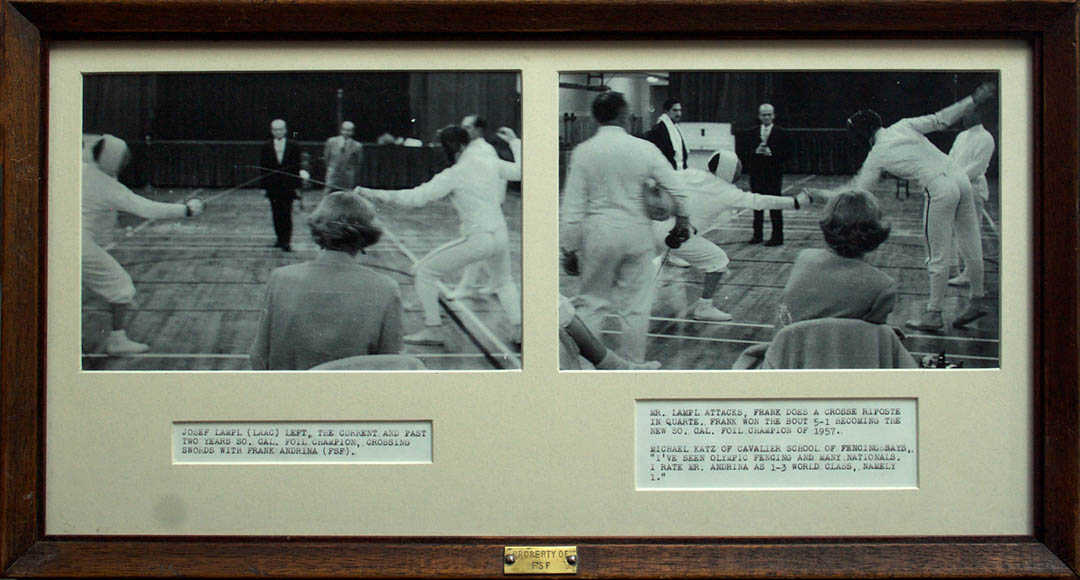


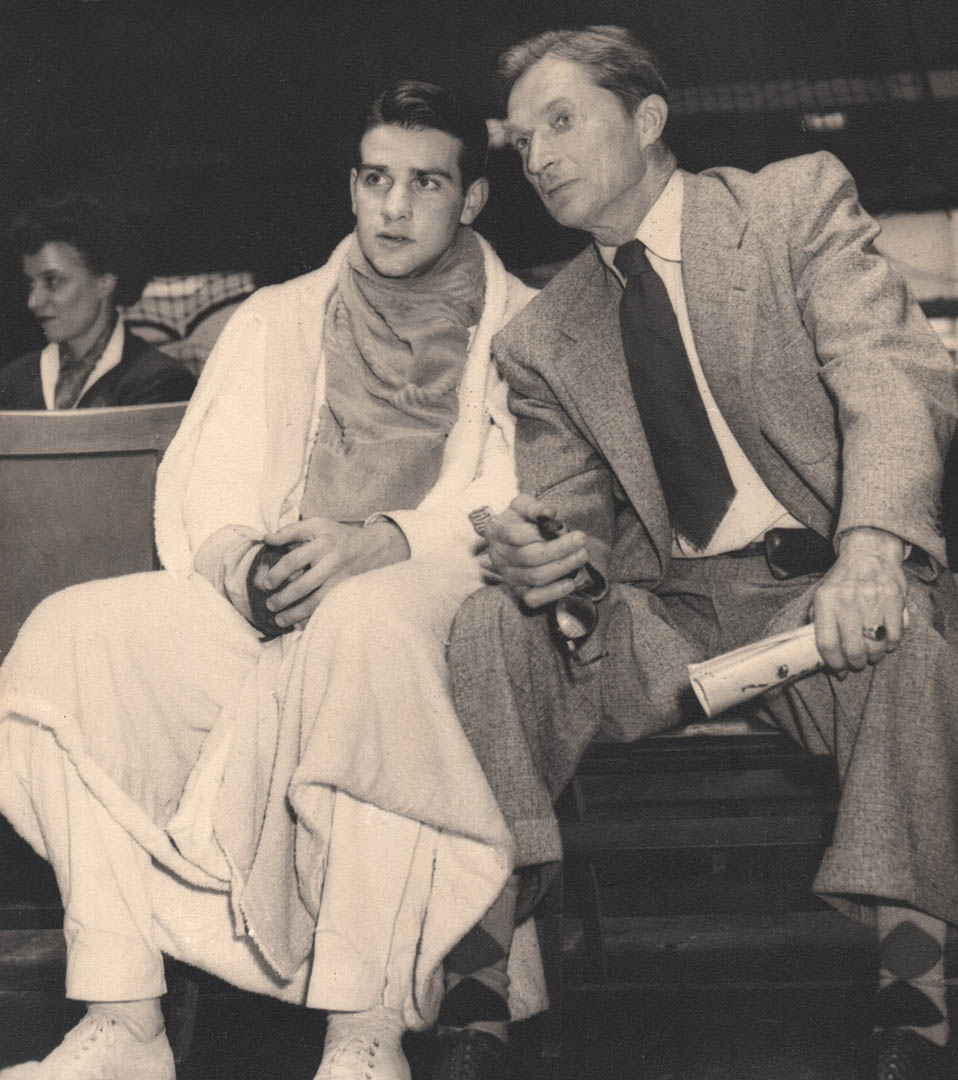

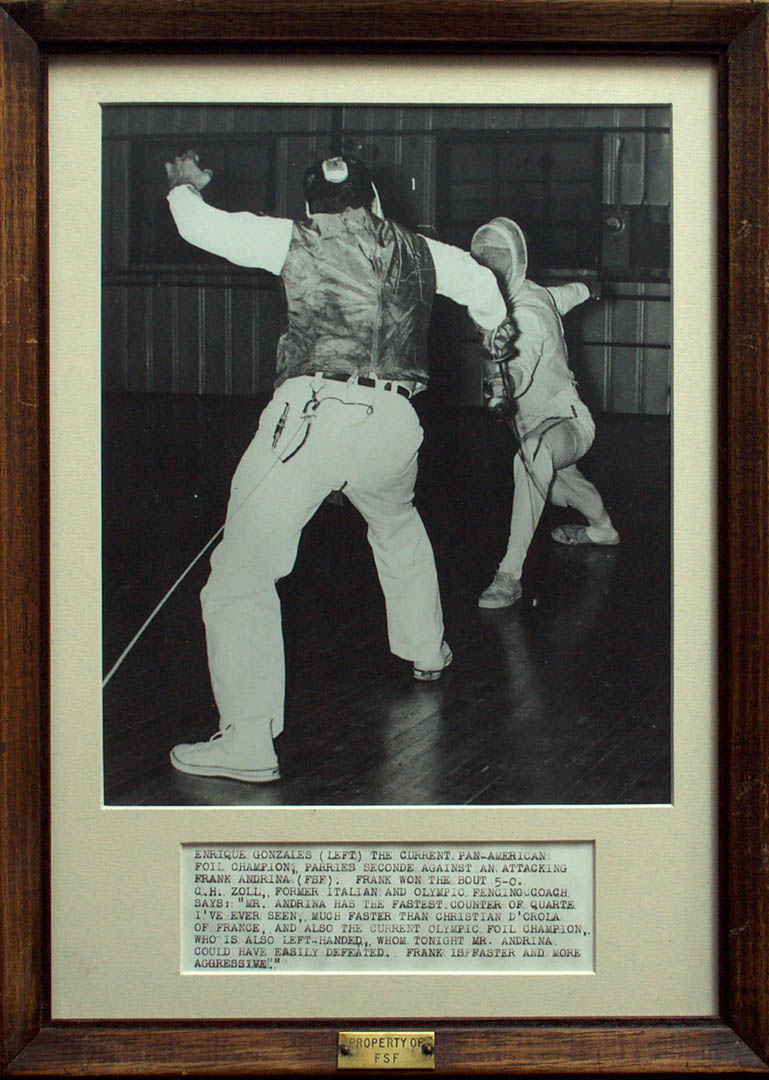
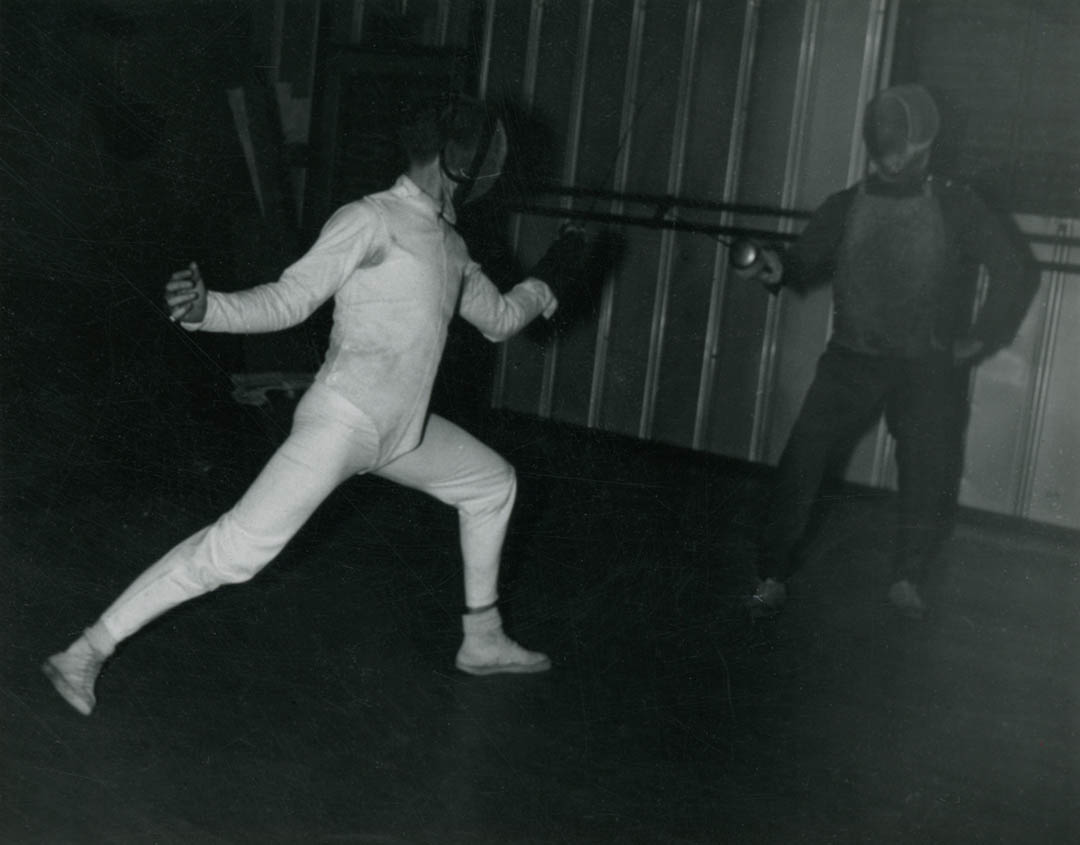
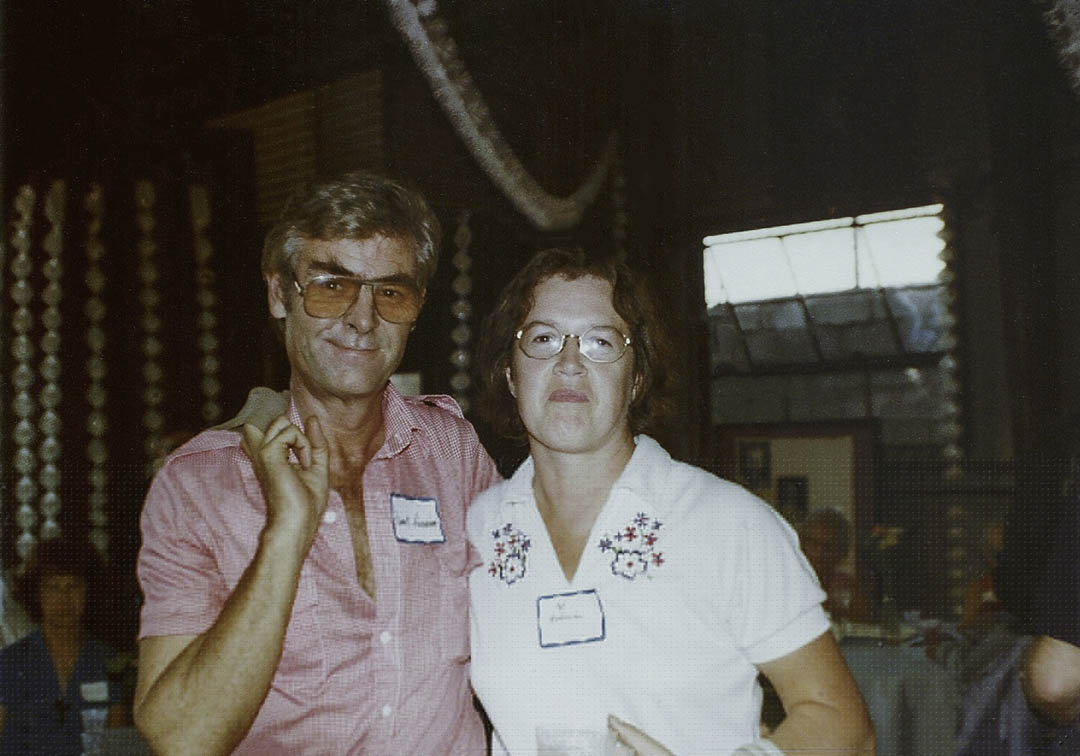
Wow! Just stumbled across this site. I’m 86——(I keep thinking,…not possible)—–and started fencing with Ralph in 1950 when I was 16. I’m not gonna do it here, but I could go on and on about So. Calif. fencing during this time span. I was friends with Sewell, who won everything at this time (he sorta superseded Ed Carfagno). Two people in your 3rd photo from the top; kneeling front and center, Al Davis, Frank’s good buddy; standing on the right, Bob Crawford who went from Prep to Senior real fast. Man, he was quick! Trivia: Sewell chipped one of the steps in our family pool when he was over swimming, but I can’t remember exactly how. Also in roughly the mid 50’s, I switched from Faulkner to Aldo Nadi. Then, after a couple years switched back to Faulkner because Nadi didn’t have enough suitable fencers to permit me to fence in the team competitions. I still have the letter I received from Nadi reflecting his ‘displeasure’ with me switching back to Faulkner. So, when I read what you said about switching, I certainly can relate. Whatever. I got started fencing because of Polly Craus who was a script girl in the motion picture industry. My dad was an assistant director/production manager and they were talking, shortly after she won the National Championship and that’s how I ended up at Faulkner’s. I could go on forever. If you have any questions, feel free to write back and ask.
I am Barbee ANDRINA Frank ANDRINA
Was my husband. I am the person who cautiously dropped off Frank fencing pictures. .. I do have more. He did his practice in Hollywood.
Am very why since the owner was not there
Gentleman dit not mention the whole story.
I dropped off his fencing medals and some trophies of his. I will go to Placentia and check out the display. Frank would like in a fencing school. He was an excellent fencer.